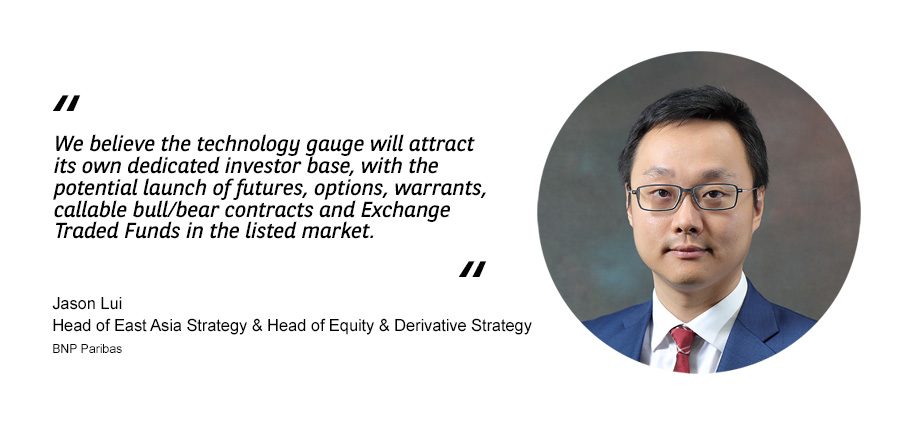This content is also available in:
Hong Kong is the number one offshore listing venue for mainland Chinese companies, which reflects an increasingly innovative domestic economy – but the city’s key equity indices have long been dominated by constituents from more traditional sectors. That disconnect is set to change with the launch of the Hang Seng TECH Index in July.
The newly-minted technology gauge represents the top 30 technology stocks listed in Hong Kong, including companies in sectors like internet, fintech, cloud computing, e-commerce and digital services. Hang Seng TECH complements the benchmark Hang Seng Index (HSI) and the Hang Seng China Enterprises Index (HSCEI), which tracks large mainland companies listed in the city. It also has the potential to change investing in Hong Kong, according to BNP Paribas.

“We believe the technology gauge will attract its own dedicated investor base, with the potential launch of futures, options, warrants, callable bull/bear contracts and Exchange Traded Funds (ETF) in the listed market,” says Jason Lui, Head of East Asia Strategy & Head of Equity & Derivative Strategy at BNP Paribas.
With longstanding Hong Kong heavyweight Tencent Holdings, e-commerce giant Alibaba Group Holding and recently-listed Meituan Dianping as its top three weighted stocks, Hang Seng TECH reflects an ongoing shift in investor interest from old economy stocks to innovative, high-growth companies.
Hong Kong IPOs: Time to shine
Hang Seng TECH is a purely quantitative gauge (qualified by sector/theme, turnover, market capitalisation, etc.), so whenever new, big and liquid “innovative” stocks are added to the market through Initial Public Offerings (IPO) or secondary listings, they will likely be added to the index, says Mr. Lui. “This positive feedback loop should continue to energise investor interest in the index,” he adds.The launch of “Hong Kong’s Nasdaq”, as local media has dubbed the index, has coincided with a resurgent IPO market in Hong Kong.
As tensions mount between the U.S. and China, a series of New York-listed Chinese companies have pursued “homecoming” secondary listings in Hong Kong. Since e-commerce giant Alibaba’s secondary listing in Hong Kong last November, gaming company NetEase and online retailer JD.com have followed suit.
“The launch of Hong Kong’s Nasdaq, as local media has dubbed the index, has coincided with a resurgent IPO market in Hong Kong.”
Others are avoiding listing in the U.S. altogether: Alibaba-controlled
payments company Ant Group plans to list its shares in Shanghai and Hong Kong,
in what may be the biggest IPO ever.
Changing of the guard
Meanwhile, the Hang Seng Indexes compiler has been making changes to its two existing flagship indices. Effective September, Alibaba was added to the 50-stock benchmark Hang Seng Index as the compiler allowed secondary listings to be included. Smartphone maker Xiaomi was also added to the gauge.Despite these updates, Hong Kong’s two main gauges – the HSI and the HSCEI – remain heavily tilted towards old economy stocks such as financials and industrials because of the index selection criteria. That being said, the weighting of financials in HSCEI has been greatly reduced from over 70 percent to around 35 percent over the past few years.
“We believe that we’re at the beginning of a multi-year index transition and we’ll probably see dramatic changes to HSI and HSCEI,” says Mr. Lui. He adds that the technology stocks represented by Hang Seng TECH could benefit from the kind of thematic popularity that has boosted the ‘FANG’ stocks – Facebook, Amazon, Netflix, and Google (or Alphabet) – in the U.S. “These stocks can benefit from the acceleration of behavioural shifts caused by Covid-19 , in spite of weaker overall economic growth,” he adds.

Hang Seng TECH’s liquidity should prove attractive to investors: its 30 components account for about 35 percent of the Hong Kong Stock Exchange’s cash equity turnover. Some 18 of the 30 Hang Seng TECH stocks have an average daily volume of more than US$50 million, giving the index as a whole estimated basket liquidity of US$700 million a day, according to BNP Paribas.
However, the new index is also expected to be more volatile than the broader Hong Kong market. Hang Seng TECH has significantly outperformed the HSI and HSCEI this year, but it has a much higher volatility profile: its three-month realised volatility is about 20 points above that of the HSI and the HSCEI, which are skewed towards more stable, blue-chip stocks.
This volatility itself could prove attractive to investors, who can gain exposure via structured products. “We also have some interesting volatility ideas,” Mr. Lui says. “These new sector stocks tend to be more volatile than traditional stocks – but higher volatility and risk go hand in hand with higher return potential.”
Southbound buyers
Investors from mainland China – via Hong Kong’s Stock Connect links with the Shanghai and Shenzhen bourses – already own US$46 billion worth of Hang Seng TECH stocks, which is nearly a quarter of all “Southbound” holdings. Only Alibaba, JD.com and NetEase – which are also listed on the mainland – are not eligible for Southbound trading at the moment, and Hong Kong Exchanges and Clearing has said it is working with mainland authorities to address that.Investor demand from the Chinese mainland was also demonstrated in August, when two domestic asset managers filed paperwork to launch ETFs that will track the Hang Seng TECH index. “The potential listing of equity derivatives and ETFs should boost Hang Seng TECH’s trading flows,” says Mr. Lui. “Since mainland investors can already access most individual stocks via Stock Connect, we think they are more likely to focus on index-based products to gain access to US-HK dual-listed companies that are currently unavailable in the Stock Connect scheme.”
